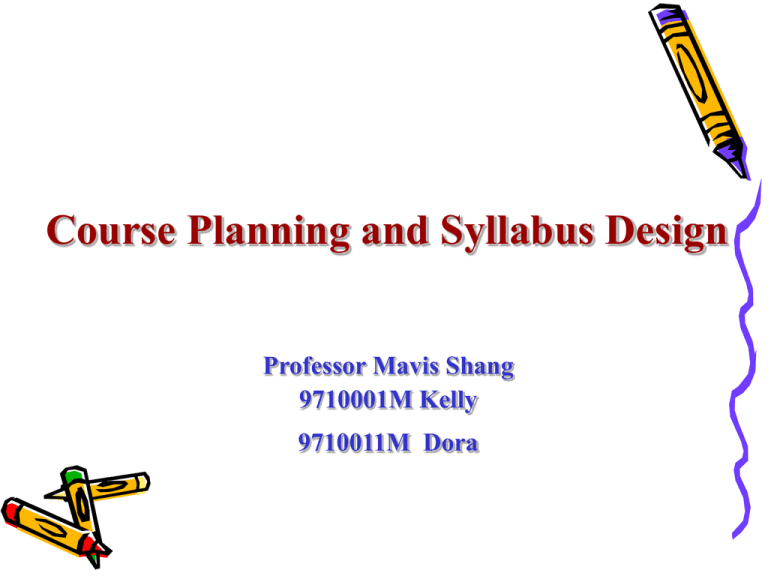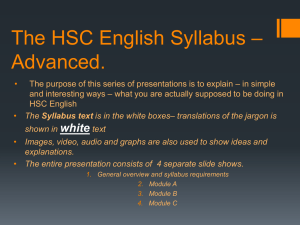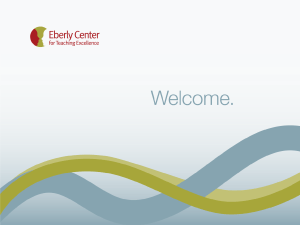LANGUAGE TEACHING material and curriculum design
advertisement

Course Planning and Syllabus Design Professor Mavis Shang 9710001M Kelly 9710011M Dora The Dimensions of Course Development • • • • • Developing a Course Rationale Describing Entry and Exit Level Choosing Course Content Determining the Scope and Sequence Preparing the Scope and Sequence Plan • Planning the Course Structure The Course Rationale • Who is the course for? – Students, teachers, potential clients • What is the course about? – The content of the course • What kind of teaching and learning will take place in the course? – The objective of the course The Course Rationale • The purpose of rationale: – Plan various components of the course – Exemplify the kinds of teaching and learning the course – Provide the consistency of components of course in terms of course values and goals The Course Rationale • An example of a course rationale: – Goal: Working adult wish to improve their communication skills in English in order to improve their employment prospects. – Content: It teaches basic communication skills needed to communicate in a variety of different work setting. – Role of teacher: 1.enable participants to recognize their strengths and needs in language learning 2.give them the confidence to use English more effectively to achieve their own goals. Describing the Entry and Exit Level • To plan a language course: =>to know the level at which the program will start =>the level learners may be expected to reach at the end of the course • Language program and Commercial materials => elementary, intermediate, advanced Describing the Entry and Exit Level • An approach is used in language program planning to identify different levels of performance. • ex: the Australian Migrant Education On-Arrival Program – in order to ensure that a language program is coherent and move learners towards that level of proficiency – the levels from 0 to 9 (Native-like proficiency) – detail description of language behavior in all four skills—what a students is able to do at different stages Describing the Entry and Exit Level Ex: The American Council on the Teaching of Foreign Language published proficiency guidelines—Appendix 1 p.170 (speaking) 1. The levels from Novice, Intermediate, Advanced, to Superior Level—12 Stages 2. Detail description of language proficiency level in five skills—listening, speaking, reading, writing, and culture in a foreign language Describing the Entry and Exit Level • Ex: IELTS can be used for planning learner entry and exit levels in a program. – IELTS Examination—Appendix 2 p.174 (writing) – The levels from Beginner, Elementary, Intermediate, Upper- Intermediate, Advanced to Special Purpose—6 Stages (Paltridge, 1992) Describing the Entry and Exit Level • Ex: Band Descriptors: Oral Interaction Skills – UCLES/RSA Certificates in Communicative Skills in English—Appendix 3 p.176 (oral interaction) – The levels from 1 to 4Level – Certificates in all four skills—listening, reading, writing, and oral interaction (Weir, 1990) Choosing Course Content The decisions of course content: • the nature of langauge/language use /language learning/the most essential elements of language • Ex: a typical writing course – Grammar (ex: the present tense in description) – Functions (ex: like and dislike) – Topics (ex: writing about world issues) – Skills (ex: developing topic sentence) – Processes (ex: prewriting strategies) – Texts (ex: writing a business letter) Choosing Course Content • Ex: a typical speaking course – Functions: expressing opinions – Interaction skills: opening and closing conversation skills – Topics: current affairs, business topics Choosing Course Content • Additional Ideas/Sources of Content Selection from: – – – – – – Available literature on the topic Published material on the topic Review of similar course Review test/exam in the area Analysis of students’ problems Consultation with teachers and specialists Choosing Course Content • Ex: Initial Ideas of Course on the Listening/Speaking Skills – Asking questions – Opening and closing conversations – Expressing opinions – Dealing with misunderstanding – Describing experience – Social talk – Telephone skills – Situational language – Describing daily routines – Recognizing sound contrasts – Communication strategies Choosing Course Content • Ex: Review/Refine the topic of course – Are all the suggested topic necessary? – Have any important topic been omitted? – Is there sufficiency time to cover them? – Has sufficiency priority been given to the most important areas? Choosing Course Content • Ex: Review/Refine the topic of course – Has enough emphasis been put on the different aspects of the areas identification? – Will the areas cover enable students to attain the learning out come? =>initial ideas for course content take place simultaneously with syllabus planning, the type of syllabus framework will be used as the basis for the course Determining the Scope and Sequence • Scope -- Breadth and depth of coverage of items in the course. – What range of content will be covered? – What extent of topic should be studied? • Ex: the Rationale of listening and Speaking – Describing experience – How much will be included in relation to this topic? – How many periods of time in the course? Determining the Scope and Sequence • Sequence — order of content – Simple to complex Reading course: the text may be simplified at the beginning of the course and unsimplified at later level. – Chronology Writing: Brainstorming → Drafting → Revising → Editing – Proficiency course Listening → Speaking → Reading → Writing Determining the Scope and Sequence • Need: Ex:The Sequences of Social Survival Curriculum Basic literary skills Personal identification Money Shopping Time & date Telephone Health Emergencies Directions Transportation Housing Post office Banking/bills Social language Clarification Determining the Scope and Sequence – Prerequisite learning Building a foundation for next step Ex: Grammar course – Whole to part or Part to whole Reading course and Writing course – Spiral sequencing Recycling of items to ensure that learners repeat Planning the Course Structure • Two aspects of the process: – Selection a Syllables Framework Major element The basis for course focus The basis for course content – Developing Instructional Blocks The process used to make decisions about content Self-contained learning sequence Planning the Course Structure • Planner are influenced by some factors: – Knowledge and Beliefs about the Subject Area – Research and Theory – Common Practice – Trends Planning the Course Structure • Grammatical (Structural) Syllabus: =>one that is organized around grammatical items. Ex: A planner seeks to solve the problems 1. 2. 3. • To select sufficient patterns to support the amount of teaching time available To arrange items into a sequence that facilitates learning To identify a productive range of grammatical items that allows for development of communicative skills Appendix 4—presents the grammatical syllabus underlying a typical first-year EFL course Planning the Course Structure The disadvantages of grammatical syllabus: 1. Representing a partial dimension of language proficiency 2. Not reflect the acquisition sequences 3. Focus on sentence not on discourse 4. Not address communicative skills Planning the Course Structure • • • • • Grammar remain a core of many langauge course. Reasons: Teaching a language through its grammar represents a familiar approach to teaching for many people Grammar provides a convenient framework for a course Grammar represents a core component of language proficiency: communicative ability includes grammar use Planning the Course Structure • Lexical syllabus: =>One that identifies a target vocabulary to be taught. • Elementary level: 1000 words • Intermediate level: an additional 2000 words • Upper intermediate level: an additional 2000 words • Advanced level: an additional 2000+words Planning the Course Structure • Functional syllabus: =>one that is organized around communicative functions such as requesting, complaining, suggesting, agreeing. Categories of functions Imparting and seeking factual information Expressing and finding out attitudes Deciding on course of action Socializing Structuring discourse Communication repair – Appendix 5 p.179 (threshold level syllabus) Planning the Course Structure The advantage of functional syllabus: • They reflect a more comprehensive view of language than grammar syllabuses • They can link to other types of syllabus contents (topic, grammar) • They provide a convenient framework for the design of teaching materials Planning the Course Structure The disadvantage of functional syllabus: • No clear criteria for selecting or grading functions • represent a simplistic view of communicative competence and fail to address the processes of communication • represent an atomistic approach to language • lead to a phrase-book approach to teaching that concentrates on teaching expression • Students have considerable gaps in their grammatical competence Planning the Course Structure • Situational syllabus: =>One that is organized around the language needed for different situations such as at the airport or at a hotel. Ex: textbook on English for travel • On an airplane • At an immigration counter • At a bank • On the telephone • On the street • In the city • At home Planning the Course Structure • The advantage of situational syllabus: • Presenting language in context and teaching language of immediate practical use • The disadvantages: • Language used in different situations • Langauge used in specific situations may not transfer to other situation • Grammar is dealt with incidentally, so a situational syllabus may result in gaps in a student’s grammatical knowledge Planning the Course Structure • Situational Syllabus: – The elements of situation 1)The participants 2)Their role relations 3)The transaction they engage in 4)The skills or behaviors involved in each transaction 5) The kind of oral and written texts that are produced 6)The linguistic feature of the texts Planning the Course Structure • Topical / Content-based Syllabus – For linking different syllabus – Each syllabus must include some contents • Example: typical lesson- 1) selected the structured 2) content topic-based syllabus- 1) content 2) continuity across the skill areas Planning the Course Structure The advantages of content based syllabuses: • They facilitate comprehension • Content makes linguistic form more meaningful • Content serves as the best basic for teaching the skill areas • They address students’ needs • They motivate learners • They allow for integration of the four skills • They allow for use of authentic materials Planning the Course Structure • Topic-based syllabuses level: ESL programs for elementary/secondary schools teaching features: integrated others subjects • Example: Topic: culture shock teaching features: 1)integrates skills course 2) based on students’ needs (Brinton et al.) Planning the Course Structure • Some themes could discuss in the class: 1) television 7) modern architecture 2) religious persuasion 8) microchip technology 3) advertising 9) ecology 4) drugs 10)alternative energy 5) racism 11) nuclear energy 6) native Americans 12) Dracula in myth, novel, and films Planning the Course Structure • Issues that arises in developing a topic-based syllabus: How are themes, topics, and content decided on? What is the balance between content & grammar or others in syllabus? Are ESL teachers qualified to teach contentbased courses? What should be the basis for assessment— content or language? • Planning the Course Structure • Competency-based syllabus based on competencies learners are expected to master in specific situations and activities • Competencies are a description of the 1)the essential skill (social survival) 2) knowledge (work-oriented) 3) attitudes →required for effective performance of particular task and activities Planning the Course Structure • Skills syllabus : 1) belief--learning is a complex activity 2) Identify the microskills underlying the use of the four macroskills of listening, speaking, reading, & writing Planning the Course Structure • Topic- “listening to a lecture” • Examples of skills that relate to different types of language: Writing: 1) creating a topic sentence 2) distinguishing between main ideas/ supporting sentences 3) self- editing Listening:1) recognizing key information 2) using discourse markers to identify the flow of discourse following rapid speech Planning the Course Structure • Examples of skills that relate to different types of language: Speaking:1) recognizing turn-taking signals 2) introducing a topic 3) using communication strategies Reading: 1) reading for gist 2) guessing words from context 3) reading and making inferences Planning the Course Structure skills syllabus for the teaching of study skills: (p.160) Basic reference skills Skimming to obtain Scanning to locate specifically required information Transcoding information presented in diagrammatic display Note-taking skills Planning the Course Structure The advantages of skills-based syllabuses: They focus on behavior / performance They teach skills that can transfer to many other situations They identify teachable and learnable units →provide a practical framework for designing courses and teaching materials Planning the Course Structure criticized on skills syllabuses: 1) There is no serious basis for determining skills 2) They focus on discrete aspects of performance rather on developing more global and integrated communicative abilities. Planning the Course Structure • Task-based Syllabus: organized around tasks that students will complete in the target language • Examples: a) finding a solution to a puzzle b) reading a map and giving directions c) reading a set of instruments and assembling a toy Planning the Course Structure • “Tasks are activities which have meaning as their primary focus. Success in tasks is evaluated in terms of achievements of an outcome, and tasks generally bear some resemblance to real-life language use”. (Skehan 1996,20) Planning the Course Structure • While carrying out these tasks : 1) learners would receive comprehensible input 2) modified output 3) processed believed central to SLA Planning the Course Structure • The basic claims made for a task-based syllabus: 1) Tasks are activities that drive the SLA process 2) Learners will acquire grammar as a by-product of carrying out tasks 3) Tasks are motivating for learners and engage them in meaningful communication Planning the Course Structure • Task-based Syllabus: two kinds of tasks a) Real-world task b) Pedagogical tasks (p.162) Jigsaw task Information-gap task Problem solving task Decision-making task Opinion exchange task Planning the Course Structure • Factors that task –based syllabuses have not been widely implemented in language teaching: 1) definition of task 2) design and selection of tasks 3) development of accuracy Planning the Course Structure • Task-based Syllabus built around texts and samples of extended discourse • TB= situational approach analysis of the contexts in which the learners will use the language ex: 1)specific workplace 2) universities Planning the Course Structure • A text-based syllabus is a type of integrated syllabus because it combines elements of different types of syllabus • Examples of text types that can be used in planning a text-based syllabus (p.163) 1) exchanges 5) story texts 2) forms 6) persuasive texts 3) procedures 4) information texts (Feez 1998) Planning the Course Structure • In teaching from a text-based syllabus a five –part cycle is proposed that involves: 1) building the context for the text 2) modeling and deconstructing the text 3) joint construction of the text 4) independent construction of the text 5) linking related texts Planning the Course Structure • The following advantages are suggested for a text-based syllabus: 1) It teaches explicitly about the structures and grammatical features of spoken and written texts 2) It links spoken and written texts to the social and cultural contexts of their use Planning the Course Structure • The following advantages are suggested for a text-based syllabus: 3) It allows for the design of units of work that focus on developing skills in relation to whole texts 4) It provides ss with guided practice as they develop language skills for meaningful communication through texts Planning the Course Structure • Criticisms of this approach are similar to those made of competency-based approaches 1) It focus on specific skills rather then a more general language proficiency 2) It may be impractical in many situations Planning the Course Structure • An integrated syllabus: decisions about a suitable syllabus framework for a course reflect different priorities in teaching • Some questions needed to be asked: 1) Which foci will be central in planning the syllabus ? 2) Which will be secondary? → course planners need to decide between macrolevel and microlevel planning units in the course Developing instructional blocks • An instructional blocks 1) a self-contained learning sequence (own goals) 2) reflects the overall objectives for the course • Planning the organizational structure in a course involves 1) selecting appropriate blocks 2) deciding on the sequence Developing instructional blocks • In organizing a course into teaching blocks one seeks to achieve the following: 1) to make the course more teachable and learnable 2) to provide a progression in level of difficulty 3) to create overall coherence and structure for the course Developing instructional blocks • Two commonly used instructional blocks are planning by: 1) Modules: self-contained and independent learning sequence with its own objectives 2) Units: a group of lessons that is planned around a single instructional focus Developing instructional blocks • The factors that account for a successful unit include: (p.166) 1) Length 2) Development 3) Coherence 4) Pacing 5) Outcome Preparing the Scope & Sequence Plan • The Scope & Sequence Plan – a listing of the module/ unit – contents -- an indication of how much teaching time • textbooks usually consists of (p.195) -- unit-by-unit description of course -- cross-referenced—syllabus items • Thanks for your listening







